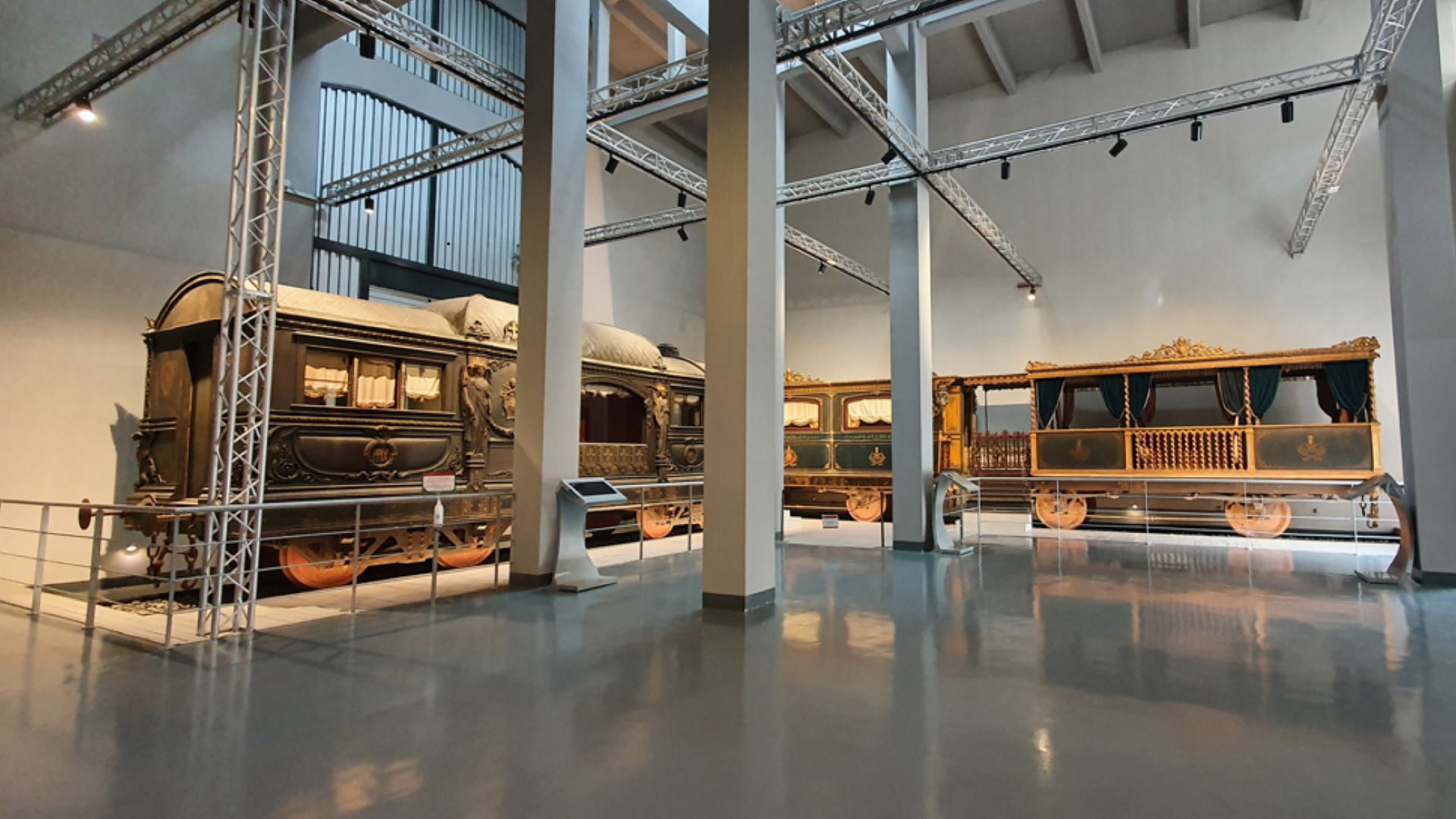
La Centrale Montemartini est un musée atypique, un lieu unique où de gigantesques machines et de puissantes turbines servent de toile de fond à des statues de marbre et à des pièces du monde classique, dans une combinaison très originale d'art ancien et d'archéologie industrielle. Les espaces de ce qui fut une centrale thermoélectrique moderne et fonctionnelle jusqu'en 1963 – commandée en 1912 par l'ingénieur Giovanni Montemartini – abritent également une œuvre d'art et d'ingénierie spectaculaire et tout aussi singulière, qui raconte une page de l'histoire moderne de Rome.
Le pape en train
Depuis 2016, l'ancienne Salle des Chaudières du musée abrite les wagons de train du pape Pie IX, né Giovanni Maria Mastai Ferretti, élu au trône pontifical en 1846. Contrairement à son prédécesseur, le nouveau pape s'était montré immédiatement attentif à ce moyen de transport, qui circulait depuis quelques années dans de nombreux États européens, et dès le lendemain de son élection, il avait nommé une commission chargée d'étudier les projets de construction de lignes de chemin de fer reliant Rome aux principaux centres des États pontificaux. Contraint de se réfugier à Gaeta à la suite des révoltes de 1948 et de la brève expérience de la République romaine, Pie IX avait alors expérimenté personnellement la portée novatrice du chemin de fer. De fait, à l'invitation et en compagnie du roi des Deux-Siciles, Ferdinand II de Bourbon, le pontife avait effectué son premier voyage en train de Portici à Pagani, la première voie ferrée construite sur le sol italien, pour ensuite visiter le Reale Opificio di Pietrarsa (Usine royale de Pietrarsa), les ateliers sidérurgiques où l'on fabriquait également les puissantes locomotives napolitaines.
Un don moderne et précieux
De retour à Rome au printemps 1850, il commanda ainsi la construction d'une série de liaisons de chemins de fer : La première ligne (ligne Pio Latina), inaugurée en juillet 1856, parcourait le trajet (19 kilomètres) entre Rome et Frascati en un peu plus d'une demi-heure. Quelques années plus tard, les lignes ferroviaires construites dans les États pontificaux couvraient déjà plus de 300 kilomètres avec les lignes Roma-Civitavecchia (ligne Pio Centrale), Roma-Velletri-Ceprano et Roma-Ancona-Bologna. Dans ce climat d'enthousiasme pour les chemins de fer, le premier train papal fut inévitablement commandé par les compagnies « Pio Centrale » et « Pio Latina » pour remercier le pape. D'un coût astronomique de 140 000 francs, le train, fabriqué en France, était arrivé dans la cité des papes au terme d'un long et aventureux voyage : par voie fluviale jusqu'à Marseille, puis par voie maritime jusqu'à Civitavecchia et enfin de nouveau par le fleuve jusqu'au port fluvial de Ripa Grande. Le 3 juillet 1859, le précieux petit train fit son voyage inaugural, en entrant triomphalement dans la gare de Cecchina, accueilli par une foule impatiente, après être parti de la gare de Porta Maggiore, qui était alors le terminus des lignes ferroviaires papales.
Frises, brocarts, velours et dorures sur rails
La puissante locomotive du train transportait trois wagons, véritables œuvres d'art sur rails. Le premier wagon, partiellement ouvert, est la « Balconata » : une « loggia mobile » pour les bénédictions papales, richement décorée de petites colonnes torses dorées, de frises végétales et de fleurs en cuivre ciselé à l'extérieur et, à l'intérieur, de dorures et de velours, avec un faux voile parsemé d'étoiles sur la voûte. Tout aussi beau, le second wagon, la salle du trône, avec un petit appartement attenant pour l'usage privé du pontife. L'intérieur était dominé par les tons papaux de blanc et de jaune, avec des fils d'or et d'argent qui rendaient la pièce encore plus précieuse. La chaire papale, surmontée d'un baldaquin et réalisée selon la technique du capitonnage, très en vogue au XIXe siècle, était placée au centre de la pièce. Des sculptures, frises et reliefs en cuivre argenté et doré ornaient également l'extérieur du somptueux wagon de la Chapelle, où le pape célébra la messe lors de l'un de ses voyages. Des artisans et des artistes français de renom, tels que les peintres Gérôme et Cambon, ont pris part à sa décoration : outre les sujets sacrés évidents, les bénédictions accordées par Pie IX à un chemin de fer et à un port – les infrastructures de transport les plus modernes de l'époque – sont représentées sur les voiles de la voûte.
Le dernier voyage
Quelques années plus tard, l'histoire de Rome allait radicalement changer de direction : l'activité du train fut donc assez courte et le pape fit très peu de voyages. Après 1870 et la prise de Rome, les trois wagons, longtemps logés dans un dépôt de la gare Termini, furent dépouillés de certains de leurs ornements. En 1911, à l'occasion du cinquantième anniversaire du Royaume d'Italie, le train de Pie IX fut exposé comme relique historique au Château Saint-Ange avant d'être transféré en 1930 au tout nouveau Musée de Rome, alors situé dans la Via dei Cerchi. De là, le 2 août 1951, après un défilé spectaculaire dans les rues de la ville sur un bogie, les wagons arrivèrent au nouveau siège du musée, au Palais Braschi, où ils furent placés dans les salles du rez-de-chaussée donnant sur la Piazza Navona, en excluant de fait la possibilité d'y accéder de ce côté. C'est justement pour retrouver la splendide vue du palais sur la Fontaine des Quatre Fleuves que le spectaculaire convoi ferroviaire a finalement trouvé sa dernière place dans les salles spacieuses et lumineuses de la Centrale Montemartini.
Tous droits de reproduction réservés











































